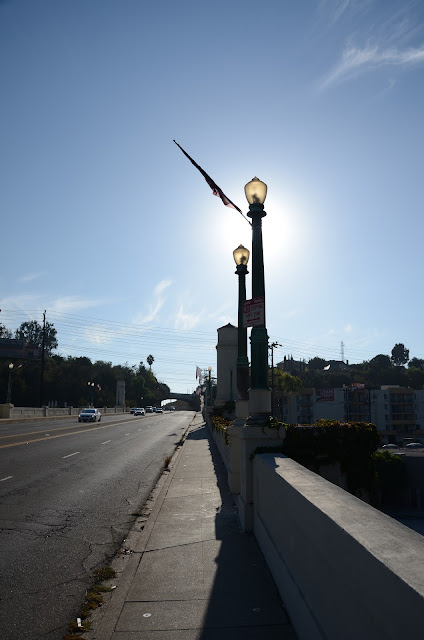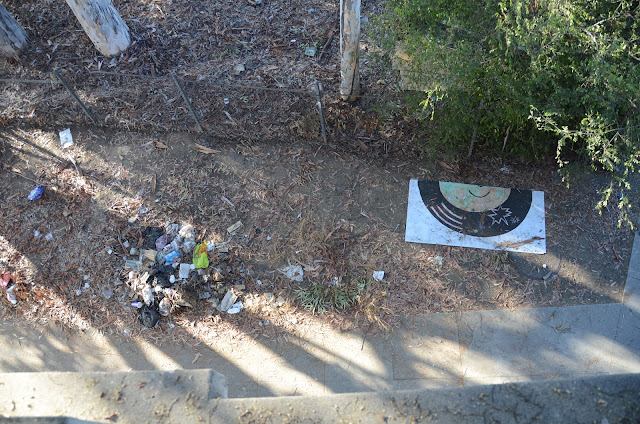I don't recommend walking over this bridge alone at night, especially if you are a young lady... I fear, too much of Los Angeles has many predators. If you decide to visit come in a group, and watch each others backs.
The Glendale-Hyperion Bridge is a concrete arch bridge viaduct in Atwater Village that spans the Los Angeles River and Interstate 5. The Hyperion Bridge was constructed in 1927 by vote of the citizens that lived in Atwater Village at the time, and was completed in February 1929. The bridge spans 400 feet over the Atwater section of the Los Angeles River and has 4 car lanes. The bridge has become more widely known because of existence of a small-scale replica of it at Disney California Adventure Park in Anaheim, California
Before the building of the Glendale-Hyperion Bridge there was a wooden bridge occupying where it now stands. The bridge that was built around 1910 served as the main entrance to Atwater Village. After a large flood in 1927 the old wooden bridge collapsed into the water.
In 1927, when Atwater Village was undergoing a large expansion in population, people needed to have an easier way of crossing the Los Angeles River. After the collapse of the original bridge Atwater needed a more convenient way of traveling to downtown Los Angeles. That year the citizens of Atwater Village, which was about 2,100 individuals, voted for the building of a new bridge to cross the Los Angeles River On March 27, 1927 construction began on the bridge. The original idea of building a bridge to cross the river was expanded to so the bridge would cross the pre-5 freeway. When the construction started, the city called the architectural designer, Merrill Butler. Merrill Butler bought 35,000 cubic yards of concrete and 6,000,000 pounds of reinforcing steel. They also drove about 1,500 wood and 3,200 concrete piles to support the piers and abutments. They also constructed 13 arches on the bridge. In total, Merrill Butler spent about $2,000,000 on the construction of the bridge. Butler decided to put in a section for trolley cars to cross the bridge along with cars. In September 1928 the Hyperion Bridge was officially opened.
In 1929 the Pacific Electric Railway constructed a line next to the Hyperion Bridge that would have Red Cars cross the Los Angeles River and down Glendale Boulevard. Up until 1959 the Red Cars would routinely cross the Los Angeles River next to the Hyperion Bridge. The line was shut down in 1959 in favor of Freeways. Today the concrete walls that held up the Red Car tracks still stand although the tracks have since been dismantled.

































It amazes me that the Hyperion Bridge was designed to accommodate a freeway that didn't happen until 30 years later. Shows that the idea for freeways goes back a lot farther than people think.
ReplyDeleteMost definitely Tony.. There are lot's of areas in Los Angeles examples being the Hyperion and the 110 Freeway Overhanging Freeway structures. It's truly a marvel of our past.
DeleteGreat photos Jason. Where exactly were the tracks for the red cars?
ReplyDeleteI believe they were south west of where the bridge is standing today. :)
DeleteThe Red Car crossing is SW of the Hyperion Bridge. It was never part of the bridge.
ReplyDeleteIf you read the article, it says it was constructed next to the bridge, not on. Happy new year!, you might of misread the article!
DeleteDose anyone remember the LA zoo bridge to the entrance around 1988-89?
ReplyDeleteDose anyone remember the LA zoo bridge to the entrance around 1988-89?
ReplyDeleteAll I know is that there was a merry-go-round!! down by the river that was taken out circa 1954 but I looked for it whenever we drove over that bridge. Heartbroken! But if must have been there for the kids at Rodger Young village, which was emptying out
ReplyDelete